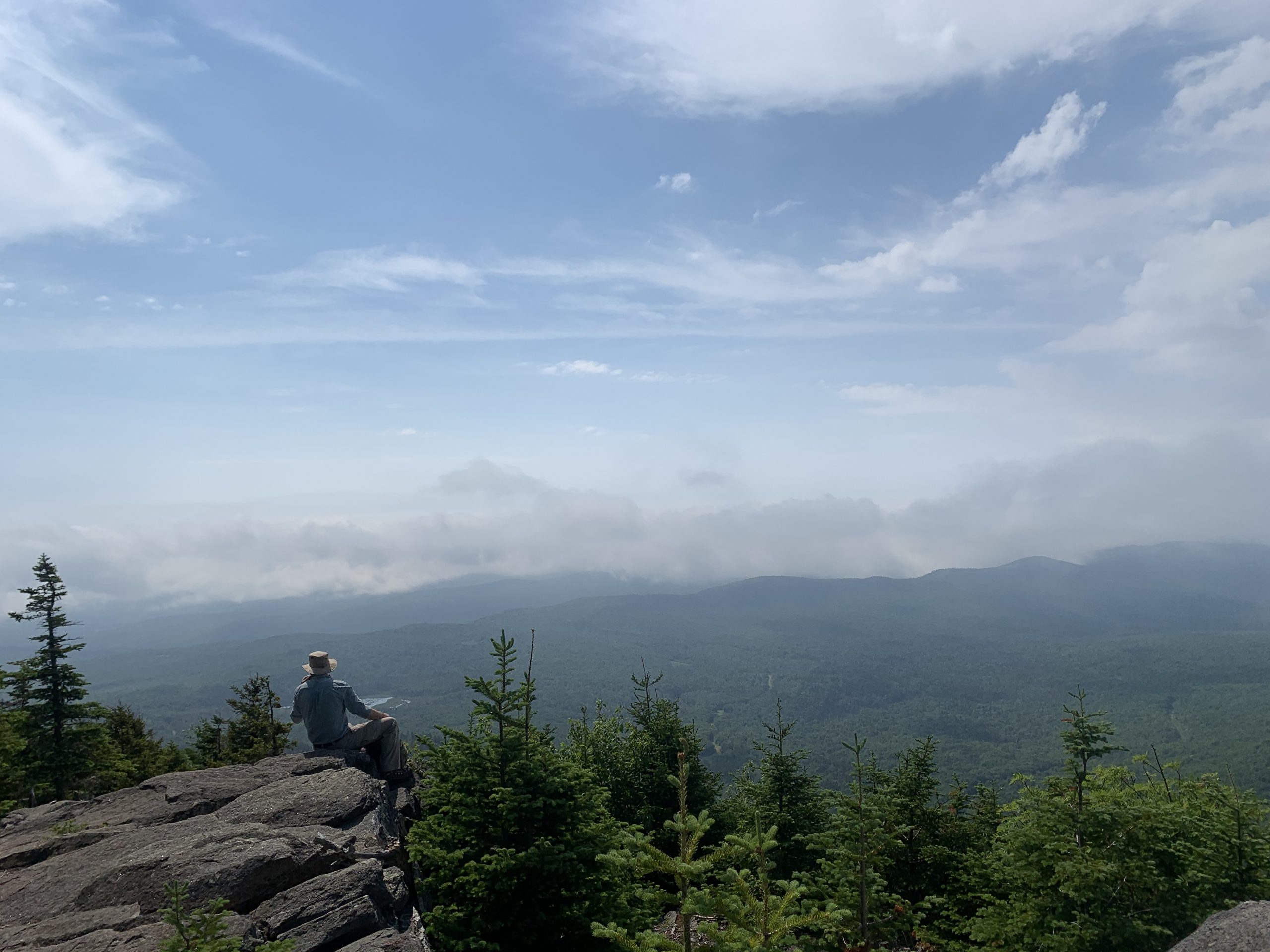
It was on a cool September day nearly 40 years ago when I summited Mt. Blue for the first time, on a hike with my wife and our children. Mt. Blue is a Franklin County icon, a striking cone-shaped peak, rising markedly above surrounding foothills, commanding the high ground to the east of the broad Weld Valley and Webb Lake. No wonder it served as a Maine Forest Service fire tower site for decades. Directly southward and southeast, there is no higher point in Maine, all the way to the sea.
On a bright morning, when a low bank of tattered cloud cover hovers over Webb Lake and the surrounding lowlands, but the heights of the Weld mountains stand in the clear, I return for another in dozens of Mt. Blue ascents over the years.
Today I am prompted by COVID-19 factors to appreciate what outdoor opportunity lies not far from home; and to slow life down a bit – to listen closely, and to approach the Maine Mountains with fresh eyes. One term for this is “slow-hiking”; another is to hike “in discovery mode”.
A hiking companion and I drive to the Trailhead parking lot in the Mt. Blue unit of Mt. Blue State Park, off the Center Hill Road in Weld. The final 2.5 miles of driving is over the graveled Mt. Blue Road. The most recent occasion I climbed the mountain it was by a combination of skies, snowshoes, and crampons.
I skied those 2.5 miles, switched to snowshoes for most of the ascent, and donned crampons for the slippery crust and high elevation ice near the top. No such conditions today.
On Trail

The trail to the top is 1.6 miles one-way (3.2 miles round-trip). Because the ascent is steady, and in places, steep,, and my plan is to often to stop, look, listen, I allow 1.5 hours to reach the top. Although we have an early start, we meet a pair of other hikers who are on the descent.. They are from New Jersey and camping at the State Park. Their plan is to spend the better part of a week hiking the Weld Mountains, with a different hike each day. As they continue downward, for a time my companion and I are the only people on the mountain.
But we are hardly the only living things around. A well-camouflaged wood toad hops across the rising trail, shades of brown, whitish rings blending well with the leaf litter. We soon see one more, and then another. As we peer the way of the toad, I notice thick moss beds nearby, and the remarkable beauty of a diminutive star flower – six white petals, six green leaves. Seeing one, I notice others, dozens of them, stretching off into the thick fir on either side of the rocky trail. Never fails: stop, look around. Creatures of the woods, flowers, distinctly different mosses, curious rock formations, begin to appear. They were there all along of course. One could say they were hidden in plain sight.
As for rockiness – well, that is the nature of the Mt. Blue Trail. Trail crews did the heavy lifting to install rock steps years ago, to minimize erosion. Quite a task, digging out the rock, transferring it from one point on the mountain slope to the trailbed, fitting it in place. Each rock placement a supreme effort.
Up we go, minimizing conversation, listening for sounds of the forest, step by step. The essential sound is that of our own breathing – until I hear the rattle of the brook that runs down the steep draw to the north side of the trail. A side path leads to the water. Though recent days have been hot and dry, and many a brook below has dropped to August levels, this high-lying brook runs fresh, moderately full, clear, and cold. The mountain continues to release the fruit of the deep winter snow pack, even now, in summer.
Heating up, I dip a bandana in the brook, wrap it around my neck. Whoa! That gets my attention! The water is truly cold. Cheap air conditioning!
This brook once served as the water source for the fire warden cabin, a few hundred feet farther up the mountain, on another side trail. The cabin itself lies in ruins. We stay away – no need to step on a nail. Day after day, for decades a fire warden made a seasonal home here, sometimes visited by family; ascending the mountain to keep watch, for the safety of the people of Franklin County – and beyond to all towns and woodlands within view.

I notice a fir log completely covered with moss, now a “nurse tree.” Out of it grow tiny fir, 2-3’ high, a starflower, and a handful of small plants too diminutive to identify. Surprise! Nearby grows a white lady slipper. Then, another! A variation of the pink lady slipper, the white variety tends to grow among mixed hardwood-softwood forest. These are the first lady slippers I have ever seen on Mt. Blue. Had I been deep in conversation, or had I not been scanning for discoveries in the trailside forest, I might have missed them.
The west-east ascending trail swings right at a point where the mountain extends a long shoulder northward. In winter I have crossed this shoulder on snowshoes to gain a fine view towards Avon and Phillips and the upper Sandy River Valley, to the northeast. On this day, white birch, rock maples, and beech are fully leafed-out limiting the view, but offering an broad expanse of shade. Good spot for a water break.
The route grows steeper and more rocky. One step at a time. I use trekking poles, which provide a extra push-off point on the uphills, and help with balance on steep pitches. They are handy today.
Another hiker comes up behind us, a young man from Bangor who returns to hike Mt. Blue for the first time since the days when he was a camper at nearby Blueberry Mountain Bible Camp in Weld. He has returned to ascend peaks that he reached in those camper days. Later this day, we meet a young woman from Portland, who climbed Mt. Blue with her family as a child, and is also back for the first time. When kids discover the mountains at an early age, impressions endure.
Sometimes with a scramble requiring both hands and feet, I make my way ever upward, now in a forest that is nearly all spruce and fir. The dark spruce prompted the name of the mountain, appearing in certain light to be a deep, dark blue. The exception to the conifers are stunted white birch, which at high elevation have a dark amber color, – and may even be found growing in cracks in mountain top ledge. Quite the sight.

Long Views
We reach the first lookout, west-facing, barely 100 feet below the top. I step to the open ledge, with a view of clouds still hovering over the lake. On the high ground that rings the valley, the summits of Bald, Saddleback Wind, and the Tumbledown-Jackson Range, rise above the clouds. Quite the sight. I linger here.
As the sun climbs higher and the breeze picks up, the cloud cover begins to break up. Wisps Cottony cloud clusters sweep by – below where we stand.
On to the summit, with its unusual communications tower – constructed in the style of a fire lookout tower. The old tower had fallen into disrepair after the Maine Forest Service opted for aircraft surveillance over fire towers. When a proposal came forward to install a communications tower for Maine Emergency Management, the idea developed, supported by townspeople of Weld, to design it in the shape of a fire tower. The blocked-access “cab” contains the antennae. A stairway rises 30’ above the ground to a viewing platform below the cab. Result? A 360-degree view.
Discovery
The new tower offers up another gift. As I take a seat near the base of the tower, at a ground-level viewpoint looking south towards Wilton, Jay, and the Kennebec Highlands I hear music – live music! The sound is a cross between string music and flutes. What could that be?
Answer? A southwest wind has risen, and whips across the tower framework. Metal railings of varying diameters, metal floor grates, and angled steel supports function as “strings.” Effect? Live music. This is a rare moment!

Ancient Greeks were fond of wind harps, constructing them on mountain tops and high hills. The built them in the shape of a orchestra harp. I have seen one, six feet high and nearly as wide, in the Caucasus Mountains of Southern Russia – territory once part of the empire of the Greek Emperor Alexander the Great. Now, today, on the top of Mt. Blue, I discover this Franklin County version of a wind harp.
I climb the steps to the viewing platform, linger; descend to walk to the east-lying and north-lying viewpoints by short trails of 50-60 feet each, for looks over Temple, Avon, Phillips, and northward toward the Saddleback Range, and Mt. Abraham (Abram). Consider this: Mt. Blue is the dividing point of drainage west to the Androscoggin River (Webb Lake and Webb River); and east to the Kennebec River, via the Sandy. I stand atop that divide
With some reluctance – We have spent well over an hour exploring the summit – I say goodbye to the high ground, and begin the hike down the mountain. Quite a few discoveries on this day! No two days in the mountains, no trip back to a familiar place, are ever the same.
How about you? What sights – and sounds – might you discover on your next hike in our Western Maine mountains?

(Photo by Doug Dunlap)
Summer Hiking Tips
Hiking with kids? Start them with high pay-off short hikes that will keep them wanting to do more. The Center Hill Nature Trail in Weld is only 0.4 miles long, and the views are outstanding over the Webb Lake. The 0.5 mile Hopping Frog Nature Trail at the Webb Lake unit of Mt Blue State Park winds through woods to come out on the lakeshore with a straight-ahead view of Mt. Blue.
Other favorite starter hikes include Cathedral Pines in Eustis, Narrow Gauge Pathway in Carrabassett Valley, and the many Rangeley Lake area trails of the Rangeley Lakes Heritage Trust – such as Hatchery Brook Preserve.
Text and photos
Copyright 2020
Doug Dunlap





Great story ,, always like your articles ,,,, the fire wardens cabin is a cool part of the trip.
Always a pleasure ,, great story ,,,,, the views are pretty sweet.